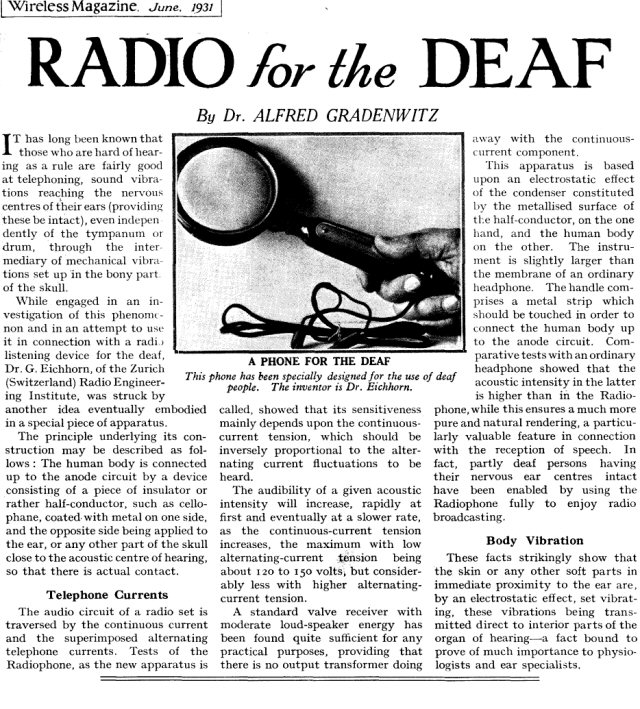Monday, April 01, 2019
Cochlear implant coulda happened 80 years ago
Science mags in the '20s and '30s often featured speculative inventions to aid the deaf. Gernsback was especially heavy on the subject, but most of his ideas were impractical. Here's an invention from a British mag that started serendipitously and actually worked. Unfortunately the inventor didn't grasp what his device was really doing, so didn't take it any farther.
From Wireless Magazine, June 1931, p 520 of the PDF. Found, of course, in the immensely valuable American Radio History library.
 Pasting some of the text:
Pasting some of the text:
 Pasting some of the text:
Pasting some of the text:
It has long been known that those who are hard of hearing as a rule are fairly good at telephoning. Sound vibrations reach the nervous centres of their ears (providing these be intact), independently of the tympanum or eardrum, through the intermediary of mechanical vibrations set up in the bony part of the skull.Bone conduction has been used by conductively deaf people for a long time, before it was formally developed into a type of hearing aid. Beethoven had a stick fastened to his piano, and gripped it between his teeth. Must have looked like he was smoking a huge noisy pipe!
While engaged in an investigation of this phenomenon and in an attempt to use it in connection with a radio, Dr Eichhorn was struck by another idea eventually embodied in a special piece of apparatus. The principle underlying its construction may be described as follows: The human body is connected up to the anode circuit by a device consisting of a piece of insulator or rather half-conductor, such as cellophane, coated with metal on one side, and the opposite side being applied to the ear, or any other part of the skull close to the acoustic centre of hearing, so that there is actual contact. These facts strikingly show that the skin or any other soft parts in immediate proximity to the ear are, by an electrostatic effect, set vibrating, these vibrations being transmitted direct to interior parts of the organ of hearing.Clearly this didn't work by mechanical vibration. Soft tissue wouldn't move enough to achieve bone conduction. This was a direct electrostatic transmitter, sending an oscillating field into the skull. The waves were then setting up impulses somewhere in the auditory system, possibly in the cochlea, possibly in the auditory nerves and brainstem. If this had been understood properly, the cochlear implant could have been developed much earlier. The current design, with dozens of frequency bands independently feeding electrodes in the cochlea, wouldn't have been practical because a tube-based frequency splitter would be room-sized. But two or three electrodes could have been fed with only a bit more complexity than the early tube-based hearing aid.
Labels: Alternate universe
